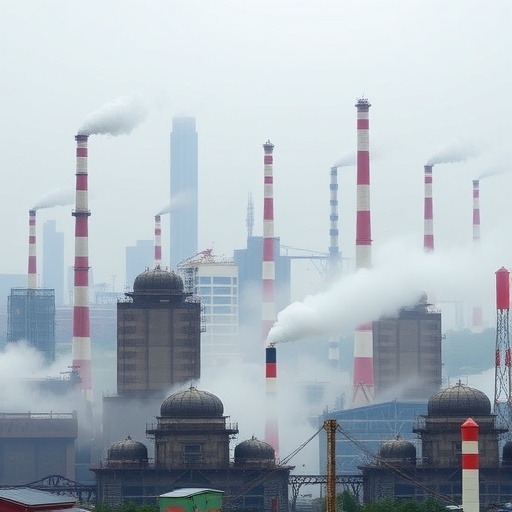As China advances into an era of unprecedented industrial growth and urban transformation, the environmental landscape is encountering a wave of novel and complex pollutants. These emergent contaminants—ranging from microplastics to previously unregulated chemical substances—represent a formidable challenge to both ecological stability and public health frameworks. A landmark study, recently published in the journal Carbon Research, meticulously examines these new pollutants in the Chinese context, shedding light on their current distribution, the substantial gaps in scientific understanding, and strategic approaches to mitigate their impacts. This comprehensive review emerges as a clarion call for intensified research and policy-oriented action in one of the world’s most dynamically changing environments.
The intricate behavior and persistence of new pollutants in diverse environmental matrices have serious implications that extend beyond localized contamination. Microplastics, for example, have been found infiltrating water systems, terrestrial soils, and atmospheric compartments, complicating traditional pollution paradigms. The chemical complexity and the sheer volume of these pollutants complicate detection and risk quantification efforts. Conventional monitoring technologies often lack the sensitivity or specificity to capture the nuanced presence of these contaminants, thereby obscuring their true environmental burden. This latest research underscores the imperative for advancing analytical methods that can track and characterize emerging pollutants with higher precision and throughput.
China’s rapid urbanization and increased industrial activities have inevitably amplified the introduction of novel chemical compounds into ecosystems. Persistent organic pollutants, pharmaceutical residues, and engineered nanomaterials have all been detected with increasing frequency, yet their long-term ecological and human health impacts remain insufficiently understood. The reviewed literature highlights that while acute toxicity can sometimes be ascertained, chronic exposure effects, bioaccumulation potential, and synergistic interactions among pollutants are areas that have been historically overlooked but are vital for comprehensive risk assessment. Addressing these multidimensional impacts requires integrative scientific strategies that combine environmental chemistry, toxicology, and epidemiology.
One of the paramount challenges identified in the study is the lack of unified monitoring frameworks and data-sharing platforms within China. Diverse regional efforts exist, often with varying methodological standards, making it difficult to aggregate data into a coherent national picture. The study proposes the establishment of standardized protocols and interoperable data systems that can facilitate real-time tracking of pollutant levels. Such improvements would enable policymakers to implement more responsive regulatory interventions and prioritize areas of highest ecological and public health risk, ultimately fostering a more coordinated environmental governance structure.
The evolution of risk assessment models to incorporate new pollutants is another critical focal point detailed in the analysis. Traditional assessment approaches have primarily been tailored to legacy pollutants, and their adaptation to novel substances, especially those with complex degradation pathways or unconventional modes of toxicity, remains an ongoing challenge. The study advocates for the development of adaptive, predictive models that integrate emerging toxicological data and exposure scenarios, thus offering a more realistic appraisal of potential hazards posed by these new pollutants over varying temporal and spatial scales.
Interdisciplinary research emerges repeatedly as a key enabler for devolving these challenges into actionable knowledge. By bridging environmental science with public health research, the study emphasizes the necessity to correlate environmental concentrations of new pollutants with epidemiological data that reflect exposure outcomes in human populations. Such integrated approaches can illuminate causal pathways or associations that have hitherto been speculative or anecdotal, thereby enhancing the credibility and applicability of environmental health policies in China and beyond.
The study’s recommendations also extend into the arena of technological innovation. Enhanced analytical techniques, including high-resolution mass spectrometry and novel sensor technologies, show promise for detecting minute quantities of emerging pollutants in complex environmental matrices. Furthermore, the integration of remote sensing and artificial intelligence in environmental monitoring proposes a transformative leap in understanding pollutant dynamics across broad geographical scales. Embracing these technologies could not only expedite pollutant detection but also enable predictive environmental modeling necessary for proactive pollution mitigation.
Policy implications form a critical component of this research, with an emphasis on embedding risk assessment within regulatory frameworks and pollution control strategies. The study suggests that existing environmental regulations in China require substantive updates to include permissible limits and management protocols for new pollutants. Public health considerations must be central to these regulatory reforms, ensuring that preventive measures, along with remediation strategies, are aligned to minimize exposure risks, particularly in vulnerable populations residing near industrial zones or polluted urban centers.
Public engagement and multi-stakeholder collaboration constitute another dimension of the proposed strategic framework. The research highlights the power of education, community involvement, and transparent data dissemination in fostering societal resilience against environmental threats. By cultivating an informed public and mobilizing industries, governments, and academic institutions toward shared goals, China can enhance the efficacy of pollution mitigation initiatives and strengthen the social fabric underpinning environmental stewardship.
Historically, China’s commitment to addressing environmental challenges has seen significant progress, with increased funding for pollution control and sustainable development programs. This study presents a pivotal evolution in that trajectory, recognizing the nuanced complexity of emerging pollutants and emphasizing a need for a paradigm shift in both scientific inquiry and policy formulation. The country’s leadership in this domain, backed by interdisciplinary scientific collaboration, could serve as a global model for confronting similar environmental issues worldwide.
From a scientific perspective, the review also points to critical knowledge gaps demanding urgent attention. For instance, the interactive effects of multiple pollutants present compounded risks that are not adequately captured by single-pollutant studies. Additionally, long-term field studies tracking ecosystem responses to new pollutants over multiple generations remain scant. These gaps underscore the necessity for designing robust longitudinal studies and improving laboratory simulation experiments to better predict ecological outcomes.
In conclusion, understanding and managing the complexities of new pollutants represent a front-line challenge for China’s environmental sustainability and public health aspirations. This study offers a comprehensive synthesis of the current status and identifies strategic pathways essential for confronting these emerging threats. By advancing monitoring technologies, standardizing data management, innovating risk assessment methodologies, and fostering robust policy frameworks bolstered by public participation, China is poised to lead the global charge toward tackling the multifaceted risks posed by new pollutants. The insights and recommendations provided herein not only chart a course for national action but also offer invaluable guidance for international stakeholders grappling with similar environmental challenges in a rapidly changing world.
Subject of Research: Not applicable
Article Title: Addressing the challenges of new pollutants in China: current status, knowledge gaps, and strategic recommendations
News Publication Date: 16-Jun-2025
References: Xu, J., Zhao, X., Jin, X. et al. Addressing the challenges of new pollutants in China: current status, knowledge gaps, and strategic recommendations. Carbon Res. 4, 48 (2025). DOI: 10.1007/s44246-025-00214-8
Image Credits: Jian Xu, Xiaoli Zhao, Xiaowei Jin, Jianqiang Sun, Ruonan Guo and Fengchang Wu*
Keywords: New pollutants; Pollution control strategy; Analytical methods; Risk assessment; Public health
Tags: atmospheric contamination and health riskschallenges of microplastics in water systemschemical contaminants and public healthecological stability and pollutionemerging environmental pollutants in Chinagaps in scientific understanding of pollutantsindustrial growth and environmental impactmonitoring technologies for emerging pollutantsnovel contaminants in urban environmentspolicy actions for environmental protectionresearch needs for pollutant detectionstrategic solutions for pollution mitigation





